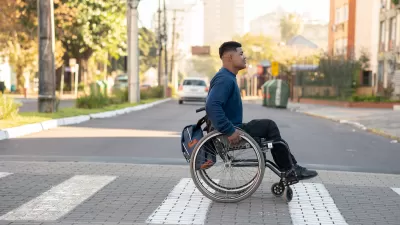Slate continues its series on wayfinding with the little-known story of the symbolic conflicts among the U.S., the former Soviet Union and Japan over how to direct people in a time of crisis.
Why does the United States insist on using a word (E-X-I-T) instead of the "running man" pictogram to mark emergency egress? Slate.com's Julia Turner brings us the history and politics of exit signs that will make you pause the next time you're faced with an unfamiliar directional sign.
Turner explains the text-based American exit sign has its origins in the 1911 Triangle Shirtwaist Fire, a blaze in New York City garment factory that killed 146 workers. But almost a century later, the National Fire Protection Association has no plans to change its signs to the globally accepted "running man" pictogram. That symbol has its own controversial past, which pitted Japan against the Soviets.
Turner acknowledges her own bias: "Although the case for the universal symbol has a certain logic, I find myself resisting it on some gut level. Ota's running man is elegant and efficient, but a bit quiet compared with the blaring red cubes I'm used to. Encountering it in London last month, I found it retiring and shy. In a fire, wouldn't we want signs to shout at us a bit?"
Maybe the 'training wheel' approach is best: running man + e-x-i-t, a combo that is now showing up all over New York.
FULL STORY: The Big Red Word vs. the Little Green Man: The international war over exit signs.

Americans May Be Stuck — But Why?
Americans are moving a lot less than they once did, and that is a problem. While Yoni Applebaum, in his highly-publicized article Stuck, gets the reasons badly wrong, it's still important to ask: why are we moving so much less than before?

Using Old Oil and Gas Wells for Green Energy Storage
Penn State researchers have found that repurposing abandoned oil and gas wells for geothermal-assisted compressed-air energy storage can boost efficiency, reduce environmental risks, and support clean energy and job transitions.

Placekeeping: Setting a New Precedent for City Planners
How a preservation-based approach to redevelopment and urban design can prevent displacement and honor legacy communities.

San Francisco’s Muni Ridership Grew in 2024
The system saw its highest ridership since before the Covid-19 pandemic, but faces a severe budget shortage in the coming year.

Colorado Lawmakers Move to Protect BRT Funding
In the face of potential federal funding cuts, CDOT leaders reasserted their commitment to planned bus rapid transit projects.

Safe Streets Funding in Jeopardy
The Trump administration is specifically targeting bike infrastructure and other road safety projects in its funding cuts.
Urban Design for Planners 1: Software Tools
This six-course series explores essential urban design concepts using open source software and equips planners with the tools they need to participate fully in the urban design process.
Planning for Universal Design
Learn the tools for implementing Universal Design in planning regulations.
Heyer Gruel & Associates PA
City of Moreno Valley
Institute for Housing and Urban Development Studies (IHS)
City of Grandview
Harvard GSD Executive Education
Salt Lake City
NYU Wagner Graduate School of Public Service
City of Cambridge, Maryland





























